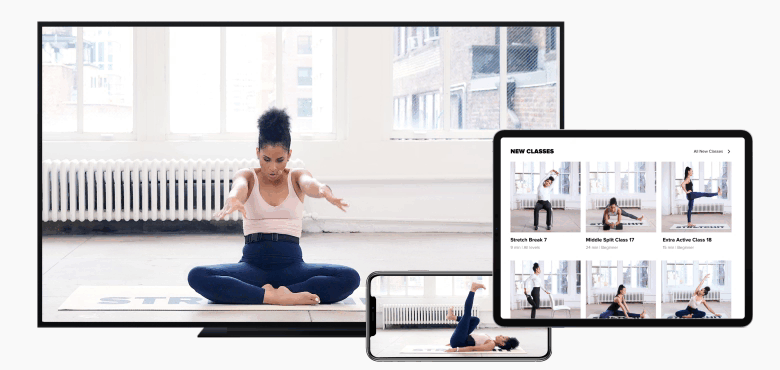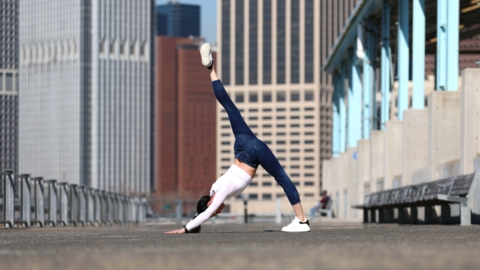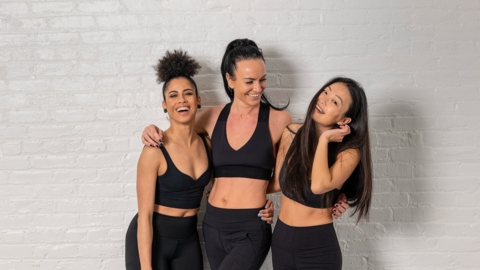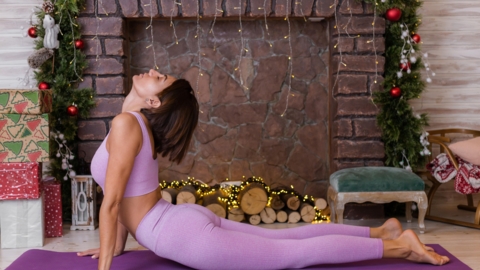10 Super Helpful Stretching Tips for Beginners
Build a strong foundation for stretching success with these tips!
As a beginner, one of the most critical elements for success is to have well-directed guidance. So, here are some of our top beginner tip so you can go after your goals confidently and successfully!

"You can learn new things at any time in your life if you're willing to be a beginner. If you actually learn to like being a beginner, the whole world opens up to you.”
1. Approach Your Training with a Positive Mindset
Getting started is the biggest hurdle, and one way you can make it easier on yourself is to be kind and positive as you approach your stretching goals. We talk a lot about positive mindset when it comes to stretching because it’s so important. When you practice positive self-talk, you'll boost your confidence and stay motivated to train.
Positivity will also help you return to the basics again and again. Don’t let your ego or unrealistic expectations get in the way of the little things you can do to stretch safely. So, what are the things you can do to take a more positive approach to your training? Try to say encouraging words to yourself, expect ebbs and flows with your progress, and thank yourself for taking the time to stretch. These small actions will help reinforce your healthy habits. Flexibility training is a marathon, not a sprint!
2. Put in the Time
Stretching is an often-overlooked element of overall fitness. While we encourage the idea that ‘everything counts’—even 10 minutes a day—we also believe that longer stretching sessions are essential if you want to make progress on a goal like a split, a backbend, a more advanced skill like standing needle or chest-stand, or even just to get stronger and more fit!
STRETCHIT classes are a minimum of 15-minutes because we want you to gain the most benefit from the training program. Studies have shown that the greatest improvements to range of motion can happen when stretches are held between 15-30 seconds and repeated multiple times. When you take your time with stretching, you’ll be able to adequately warm up, hold the stretches for the allotted time, and finish the sequences in their entirety. If something is too difficult, choose a modification that is doable but still challenging. Keep moving through the class and don’t worry if you can’t complete the number of reps that the voice instructions are giving you.
3. Experiment with Your Schedule and Find a Routine That Works for Your Body
We often get the question “Is it better to stretch intensely a couple times a week or less intensely every day?” Well, it depends on your goals! Are you working on a skill like an oversplit, or are you aiming to just hit the mat on a regular basis? The answer will also depend on your level and what your body can handle. But in general, we’d recommend a combination. Try several intense stretching days every week with lighter stretching on the alternate days–and of course, listen to your body.
If you’re doing 2-3x intense classes and 2-3x light mobilizations every week, and you feel great, then yes: add another day of intense training! But if you can’t move for a few days following an intense training session, think about easing up or modifying the exercises so that you’re not overtraining and exhausting your body. We’d also recommend trying to do a little bit every day to keep your body limber. On the lighter days, try a 15-minute class or even just take some of the moves from the classes and do them in the morning before work or in the evening before bed. Being active is a lifestyle, and more you reinforce the habit of stretching—the harder it’ll be to miss a session!

"What you get by achieving your goals is not as important as what you become by achieving your goals.”
4. Give Yourself Adequate Rest Days
Are you taking your rest days seriously? Sometimes we get so focused on a goal that it’s hard to hit pause on the training days. But don’t forget that your strength develops in the time off. On rest days, muscle fibers repair and rebuild themselves. You, you can always do a little active recovery on rest days—some light cardio or a 15-minute stretch class can help you feel more mobile and invigorated without causing additional stress on the body.
Tune in to how your body is feeling and don’t hesitate to add an extra rest day if you’re still sore or need extra recovery time. Add variety to your exercise routine so that you don’t get burned out doing one thing too often. The goal? Work smarter, not harder!
5. Square Your Splits!
Get to know the square position—it’ll be your best friend when working on your front splits! The square hips position is super important for long-term success with your lunges, splits, and pigeon pose.
To properly square your hips, your two hips points and your pubic bone should be in alignment, with your hips and shoulders pointing forward. That means pulling the front hip back and the back hip forward. The biggest piece to squaring your hips is that your inner thighs are ACTIVATED! By pulling everything in towards the midline of your body, you’ll create a balanced stretch. While this means lifting up out of your lowest ‘open split, it’ll help you go deeper in the long run. Use plenty of padding for your knees or ankles if you need to, and don’t hesitate to grab your blocks.

6. Approach Flexibility Training from a Whole-Body Perspective
When you’re working on your flexibility it’s natural to want to go right to the source and start with exercises targeting the area you want to make strides on. But think about flexibility from a whole-body perspective. Training in a balanced, progressive way can help you develop equal mobility in your shoulders, back, hips, and legs, and more—which in turn will help you achieve poses that might at first seem like the “all back or “all hamstrings,” etc. It’s often an ‘Ah-ha!’ moment when you realize that improving your hip flexor mobility will help open your back, or that increasing your overhead shoulder mobility will help you find more comfort and stability in deeper backbends. Remember that what you do for one part of your body will affect the whole system!
7. Be Patient and Kind
Alongside staying positive, two qualities that will boost your mental game for stretching (and for life!) are patience and kindness. Some days, stretching will feel magical and effortless and other days, you’ll feel like a rock. We understand! We experience these ups and downs too. Take a deep breath and exhale. Remind yourself that you’re not perfect and that’s not the goal anyway.
Your deepest, safest stretches will happen when you are patient and kind to your body. If you feel like you’re being too aggressive with your training, stop and ask yourself why you’re pushing yourself so hard. Sometimes we’re so caught up in the ‘doing’ that we don’t have any clarity about our intentions or motivations. It can be refreshing to finally see what we are doing and how we can change our ways for the better. Mental preparation—bringing positivity, patience, and kindness to your training—is one of the essentials that will lead you to personal success on and off the mat.

"The minute you get away from the fundamentals—whether it’s proper technique, work ethic, or mental preparation—the bottom can fall out of your game, your schoolwork, your job, whatever you’re doing."
8. Document Your Journey
One of the best ways to measure progress? Snap some photos! On your first stretching session, take a few pictures in poses that you want to document over time. If you do this every time you stretch, you’ll have a visual chart of your progress. It’s truly amazing to see the physical changes and it’s a great way to quantify your progress! Taking photos can help you stay on track and motivated as you work on your goals.
9. Involve Others in Your Process
We ALL need help staying motivated and on track with our training goals. One of our favorite recipes for success: ask someone to stretch with you! When you have someone by your side to help handle the struggles, laugh at the missteps, and celebrate the victories, the journey is more meaningful (and fun!). Text each other encouraging messages and find other ways to keep each other on track. Sometimes having someone by your side is that extra pillar of strength we need in order to go after more ambitious goals. Plus, it’ll make the celebrations ever sweeter after you accomplish what you set out to do!

10. Hold on to Your Beginner Mindset
The beginner mindset is a beautiful thing. As a beginner, there are so many possibilities and an open vision for where our practice and goals can take us. Sometimes, experience or expertise can get in the way of being curious, open-minded, and understanding. So, hold on tight to your beginner mindset: the one that keeps you eager for new knowledge, ready to put in the work, and excited at the victories of seeing progress! Keep up the great work. Starting is always the hardest part. Now, you’ve just got to stick with it! We can’t wait to see what you accomplish.
"Optimism is the faith that leads to achievement. nothing can be done without hope and confidence.”





